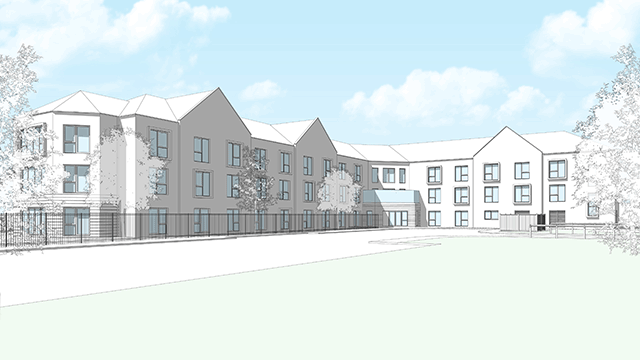You probably think you know this story: international occupiers and investors are rushing to the UK to get a piece of a fast-growing industry. They have specific requirements from the kind of real estate they want and, in short, there’s just not enough of it. Demand is outpacing supply at every turn.
But here comes the plot twist: we are not talking about life sciences and labs. We are talking about film and television studios and the industry’s growing need for space.
The film and TV business is booming in the UK. The country has for decades been a centre of excellence when it comes to the creative arts, and with our excellent skills base, welcoming tax regime and now a pound making it even more attractive for US dollar-based businesses to spend in the UK, the sector looks set for a blockbuster couple of years.
There are currently around 6m sq ft of production facilities in the UK, according to research from Knight Frank. With total production spend forecast to double over the next five years, it predicts demand for a further 6m sq ft over that period. Despite that demand, just 2.7m sq ft of space is in planning or being built.
The story writes itself, and already investors and developers are looking to play a starring role.
Investment giant Blackstone has partnered with US studio specialist Hudson Pacific Properties to build a 1.2m sq ft studio at Broxbourne in Hertfordshire, Pinewood is looking to expand its studios in Buckinghamshire by a further 1.4m sq ft, and Netflix has signed a deal with industrial developer SEGRO to turn its 230,000 sq ft Enfield business park into major TV and film studios.
Finance is flowing into the sector too. Tristan Capital Partners has stumped up £35m to refinance London North Studios in Mill Hill, NW7, while Cain International has provided more than £260m to finance the development of the almost 1m sq ft Shinfield Studios campus near Reading.
The market is hot but – like life sciences – it is also specialist, and that is where Ryan Dean, founder of global content creation company RD Group, believes he can play a vital role in establishing the UK as the premier location for world-class studio and production space.

UK success story
Dean opened his first studio in May this year. The £20m development, featuring five studios, at SEGRO’s Premier Park in Park Royal, NW10, is one of the UK’s first net-zero studio buildings. The 45,000 sq ft unit features solar panels on its roof, rainwater harvesting, EV charging points, LED lighting, air-source heat pumps and, of course, a selection of bug hotels to encourage biodiversity.
He is immensely proud of the property. But it has made him hungry for more, and he says his journey of turning an industrial unit into a fully functional studio space has taught him lessons that many trying to break into the sector will not know. Learning these lessons the hard way, he says, can be very costly.
He cites one example of a developer using the wrong sort of steel in a studio development. The steel selected by this “normal” developer, says Dean, vibrated when shots were fired on set. The vibration was inaudible to the human ear, but not to camera mics.
Dean wants to create a specialist fund to invest in studios in and around London that are developed and constructed by specialist operators like himself. He is already talking to investors to raise around £100m for its first seed investment but has ambitions to grow to more than £300m, potentially through the stock market listing of a new specialist studio REIT.
Dean says there are a number of reasons the UK studios market its growing so dramatically.
The first is that streaming services like Netflix, Amazon, Apple and Disney are creating content in volumes never seen before. According to research from Wells Fargo, the nine leading streaming companies will spend a whopping $140.5bn (£126bn) on content creation this year, a figure that is expected to jump to $172bn by 2025.
Second, the UK is a tax dream for content producers.
“It really is one of the best tax regimes for producers in the world,” says Dean. “You spend £100m here and you get £25m back straightaway. So, for every pound the government is putting in, that’s £5 back to the UK.”
Dean is confident the current government is not going to fiddle with that regime either. “The finance and creative industries are basically the only two things we could argue we are good at anymore in this country, so it would be an amazing state of affairs if the UK government said ‘we’re going to blow that one’,” he says.
The UK’s creativity and its abundance of talent is Dean’s third reason for the unstoppable growth of the sector.
“The one thing that the UK has been arguably number one in the world at is storytelling, probably going back to William Shakespeare,” he says.
And we continue to develop that creative ability with some of the best educational facilities in the world producing an ever-larger talent pool. He cites the National Film and Television School in Beaconsfield, Ravensbourne University in London and Bournemouth University and its Oscar-winning visual effects alumni as examples.
“It is disproportionate how much of the industry comes from the UK,” says Dean. “Harry Potter is a big reason for that. When they moved Harry Potter to the UK for filming and visual effects, that sparked a massive boom in the industry that has lasted for 20 years.
“But we need the buildings to keep up. We need places like this [RD Studios] to keep being built. We need the people to keep up. We’re already close to being number one and, pound-for-pound, I think we’re bigger than LA for the number of productions that are being put here.”
Creative communities
Despite the recent flurry of activity in the studio development market, Dean fears that what we are seeing come out of the ground may not be fit for purpose. And while he is talking to EG from RD Studios, a SEGRO-owned former logistics unit, he says logistics sites cannot always be easily repurposed as studios.
Height is the biggest issue. The George Lucas stage at Elstree is one of the biggest in the UK at 15m. His, at Premier Park, is 7.75m. The higher the better when it comes to studios, says Dean, so while repurposing is possible, it is not ideal.
That is why he is eyeing developing and delivering the whole package. Dean says he has been meeting with councils and the GLA to sound out appetite for full-scale studio development in and around London. Responses have been good, he says, as with studio development, as opposed to data centres, life sciences and even logistics, he can deliver more of a community.
He has his first site in mind and, while the deal is yet to cross the line, his vision is for a multi-studio development that provides a creative hub for a key part of London, delivering workshops, office space, a café and perhaps even a museum of the moving image alongside the studio space. All delivered, of course, to the highest of environmental standards.
“It’s a booming market, and it’s only going to get better,” says Dean. “My vision of where this goes when you think about virtual production, about how video game developers will use space as they continue to build, how the metaverse is going to impact this, is that we’re going to need environments that are custom-designed for that.
“You need to find someone who has their finger on the pulse of all those things and where this is going to go over the next couple of decades.”
Or, indeed, a specialist investment fund that can do it for you.
To send feedback, e-mail samantha.mcclary@eg.co.uk or tweet @samanthamcclary or @EGPropertyNews











